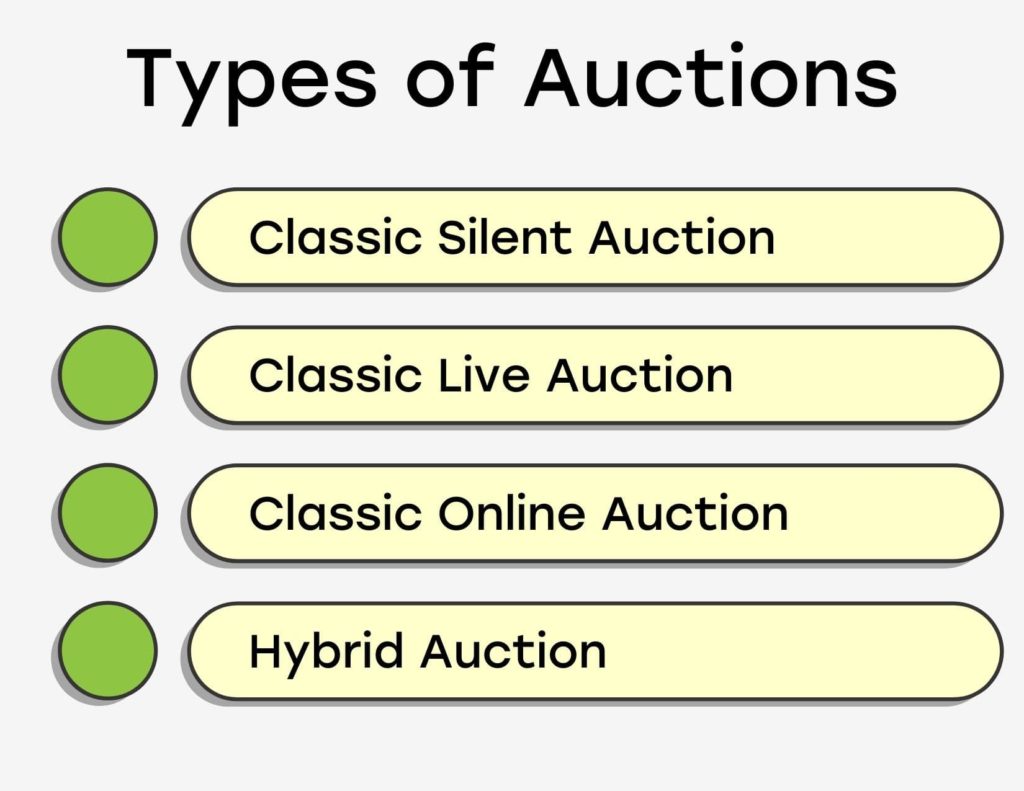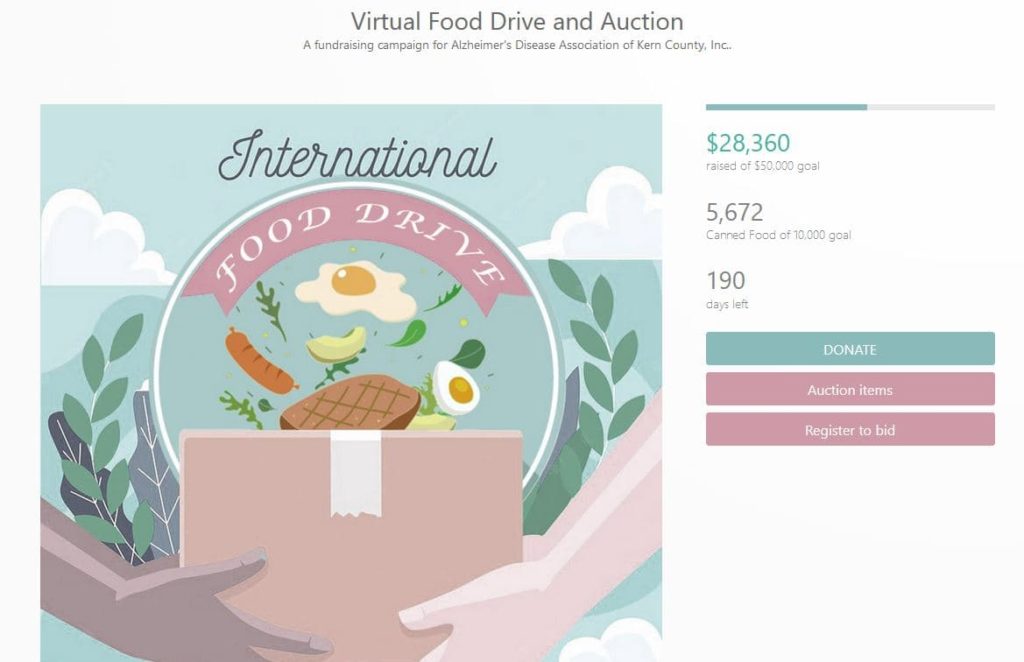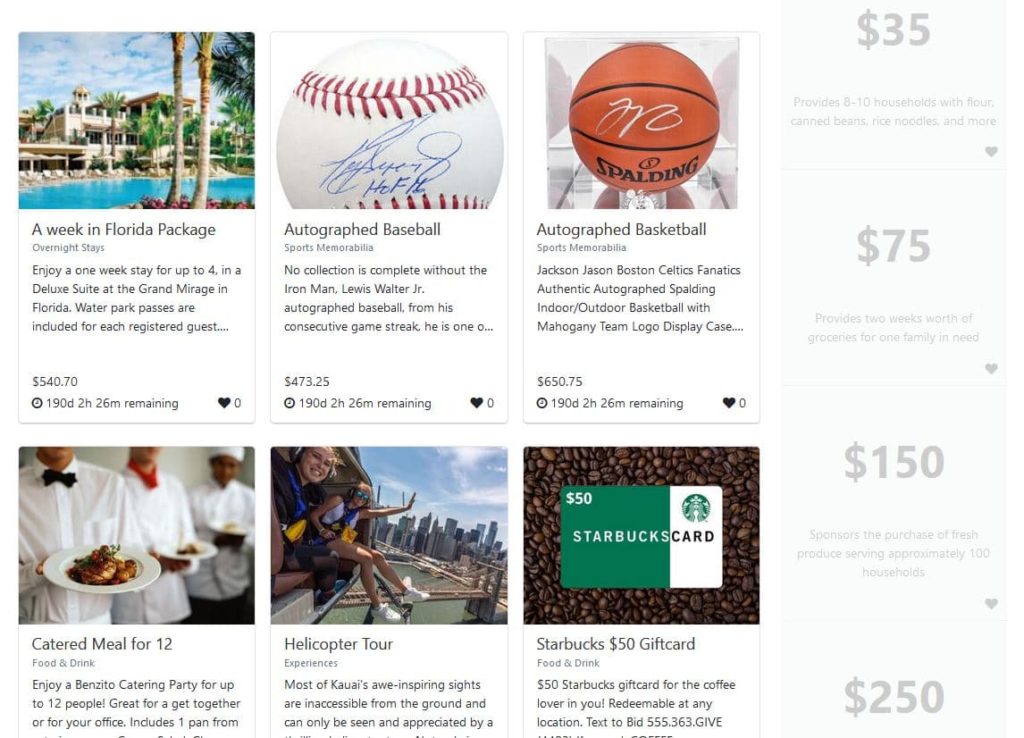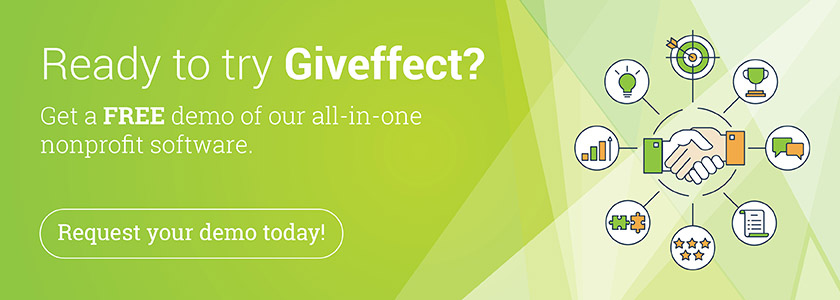Auctions are an excellent way for nonprofits to raise funds and engage with supporters. People enjoy the adrenaline rush that accompanies bidding. When the auction begins, it is as if time stands still as bidders set their sights on desired items or experiences and strive to be the winning bid.
Auctions can take shape in many different forms—from online to in-person and from rowdy live auctions to quiet silent auctions. Each nonprofit auction type comes with its own set of benefits and challenges. Some nonprofits may opt for a combination of types to meet their goals.
To help you make your nonprofit auction a success, we’ll cover:

Types of Auctions
Silent Auction:
Silent Auctions is a very common form of nonprofit auction. It typically takes place at an event, like a gala. Items are physically displayed on tables, and bids are placed on a bid sheet next to each item. Event attendees see the progression of offers and outbid the prior offer by adding their bid. The winner is simply the highest bidder on the bid sheet when time is called.
In this traditional format, an attendant is responsible for notifying the winning bidder and setting up the payment process and item transfer. Only in-person attendees bid on items in the auction. The silent auction is one of the easier types of auctions to execute; however, in this traditional format, does take quite a bit of manual on site work.
A more modern format would eliminate the need for paper and substantially reduce the steps needed to be taken by a nonprofit team. With Giveffect for example, nonprofits create web pages which house images and descriptions of the auction items with the option to bid from their mobile device. Giveffect collects bidder information and tracks the top bid in real-time. Then, automated email or text notifications notify the winner (as well as your team). Payment is processed. The only thing your team may need to do, depending on the item, is deliver the item to the winner.
Classic Live Auction:
Live auctions are usually for auctions with higher-price items. Live auctions are held during an event and may even be the main event if the items are impressive enough to draw a sufficient crowd. The items are often on display or detailed in a booklet so bidders are aware of the items up for auction before the bidding begins.
The auctioneer excites the crowd and accepts bids on each item in front of event attendees. A live auction not only raises funds but serves as entertainment. The auctioneer announces each item and collects bids. When the auctioneer is a great personality and also serves as the emcee, it is common for this person to rally the attendees and encourage them to bid higher.
An attendant is responsible for keeping track of the winning bidders, the payment process, and item transfer. In this format, only event attendees can bid. The live auction environment can lead to higher bids.
Classic Online Auction:
eBay is an example of an online auction where people from anywhere can place bids on items, and the highest bidder wins. Similarly, nonprofits need their own webpage with a page structure that can display items, accept bids, gather bidder information, and process all of this information in real time to announce the winner when the time expires. The webpage will also need to trigger communication with the winner to process the payment and provide the item.
Hybrid Auction:
Hybrid auctions are very popular amongst nonprofits. This type of auction combines an in-person auction event with an online setup for easy bidding from a variety of devices and automatic tracking. With hybrid auctions, nonprofits have the flexibility to accept bids from supporters who are in attendance or located anywhere else in the world. When the allotted time period ends, the highest bidder wins.
Hybrid auctions require a webpage and the ability to take bids from a variety of devices. Using an online auction tool with an app can make the process easier for those in person and those bidding from a distance. As with any type of auction, hybrid auctions require a process to track winners, bidders, and winner information and trigger a plan to process payments and distribute the winning items.
The advantage to this type of auction is that nonprofits can host a fun in-person bidding experience and also access bidders from around the world. Hybrid auctions maximize the opportunity for nonprofit auction success. The key to a successful hybrid auction is to have the right technology to set it up.
Mixed versions of hybrid events may offer certain higher value or higher demand items in a live auction with lower value items available via silent auction. Both options may also include online bidding.
Auctions with Giveffect
Within Giveffect’s connected system, nonprofits easily create auction pages to facilitate any type of auction—live, silent, or hybrid. For use in person, online, or a combination of the two. Easily create customizable web pages with auction functionality and features to help nonprofits share the details of the fundraiser, mission, and impact.
To set up an auction, simply add the auction items using Giveffect’s intuitive interface. Chose between a variety of settings, including options like buy-it-now and reserve pricing. And even silent auctions are an option!
One way to manage an auction at a live event, such as a gala, is to broadcast a Giveffect scoreboard to display who the leading bidder is for each item in real time. Attendees can place bids on their mobile devices using text messages to bid.
Auctions are easy to set up and execute all within Giveffect. Manage the entire process in one place, from attendees to items, to the full bidding process. Collected information, like bidder registration, is automatically added to the Giveffect CRM. Create groups to identify bidders for auction follow-up, to send thank you notes, and for outreach for the next event.
Beyond data aggregation, Giveffect automates bidding notifications, bid extensions, winner confirmation, payout fulfillment, a thank you letter, and tax receipts.
You can also host branded auction pages or third-party auctions.
Let’s look at an example of nonprofit auction success with Giveffect.
Virtual Food Drive and Auction (Real Nonprofit Example)
The Alzheimer’s Disease Association of Kern County is currently hosting a Virtual Food Drive and Auction. The nonprofit uses the auction page to share its mission and impact, along with the details of the auction. The page tracks the auction’s status and has the functionality to accept donations. This specific auction/event has already raised over $28,000 and over 5,672 cans of food. There are 190 days left on the auction.

Continue to scroll on the page to see items up for auction with a brief overview, the current bid, and the ability to favorite an item. Bidders then click on the item for more details and to learn how to place a bid via online or text message. Bidders can sort or search auction items. This is especially helpful in larger auctions with many items.

And to the right of the bidding items, you’ll find the breakdown of the impact in terms of the mission . For example, a gift of $35 provides eight to 10 households with canned beans, rice, noodles, and more. While a gift of $75 provides two weeks of groceries for a family in need.
In addition to bidding on auction items, supporters can click on those amounts to donate. So even if a supporter doesn’t see an item they want to bid on, they can directly donate and see how their donation will make an impact.
The page is intuitive to build and easy for bidders to navigate. The winners are automatically tracked within the Giveffect system. Once the auction ends, the system automatically sends the winning bidders an email. An attendant can view all the winner’s information to arrange for delivery or pickup of the winning item.
Another advantage to Giveffect is that all bidders are instantly added to your CRM, and their actions are listed, so you can see all those who participated in this event and share future events with them, including future auctions. This allows you to create targeted marketing campaigns focused on groups with very particular interests.
Why It Matters
Auctions on their own are a lot of work to set up and execute. With Giveffect your team can spend more time promoting the auction and obtaining the best items for nonprofit auction success.
When a new contact registers for your auction in Giveffect, their information is automatically added to your CRM. Easily cultivate new relationships with campaigns and targeted email options right within Giveffect.
To summarize, online nonprofit auctions are a great way to reach out and expand your contact list with individuals who may not attend other awareness events. Giveffect can give you the tools to make that outreach streamlined to save you time and increase impact. Let us answer your questions and show you how in a demo:
